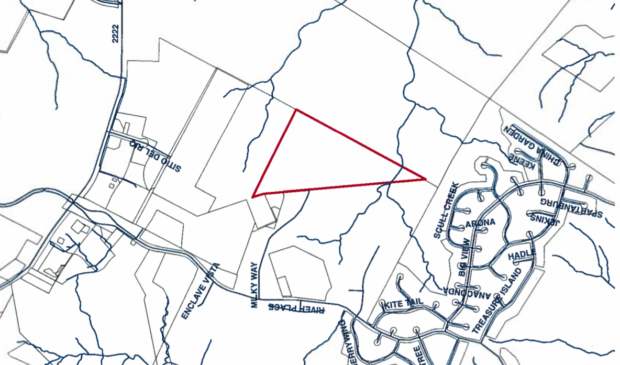Third time not the charm for River Place case at ZAP
Thursday, July 18, 2019 by
Jessi Devenyns At the end of Milky Way Drive there’s a 42-acre greenbelt buffering the River Place neighborhood from Balcones Canyonlands Preserve. Since 2015, there has been an ongoing debate over how best to develop that tract of land.
The latest hearing on the development plan came before the Zoning and Platting Commission on July 16. Jeff Howard, who was representing applicant Milestone Community Builders on the project, asked for a recommendation to rezone the property from Development Reserve to Townhouse & Condominium Residence (SF-6), which would allow up to 134 units on the site.
Commissioners were unable to come to a consensus on whether to recommend the project at a higher density than they had previously approved, and after two failed votes sent the case on to Council with no recommendation.
The case also failed to garner a recommendation from the Zoning and Platting Commission in a earlier iteration, in which the development had a maximum of 45 units and Single Family Residence – Large Lot (SF-1) zoning. It was amended several weeks later, before the case could go to Council. This was the second time the case was modified, returning it to the Zoning and Platting Commission to consider the case again, before it went on to Council for a vote.
“If zoning requests were cheese, I would classify this one as Roquefort because it has a smelly odor,” said Commissioner Jim Duncan.
He pointed to the environmental sensitivity of the region, the lack of the site’s presence in the Imagine Austin Comprehensive Plan, the imminent concern about wildfire, and the current development patterns of the neighborhood as reasons that increased density does not belong on that tract.
The new zoning case for this property would be an additional 12 percent increase to the current number of homes in the River Place neighborhood, which residents worried would pose a dangerous risk in an emergency situation like a wildfire.
Jeff Howard told the Austin Monitor that the 45-unit cap was originally agreed to as a compromise with the neighborhood, but that the neighborhood was opposed even to that level of density. With 45 units on the tract, each lot would have an average of 18,000 square feet. The River Place neighborhood asked for a minimum lot size of 30,000 square feet. Code designates the minimum lot size for large-lot single-family as 10,000 square feet.
“The neighborhood, in our opinion, wants something that’s unrealistic,” Howard told the Monitor.
At the commission meeting, he said developing the property with such large lot sizes “ensures an exclusive wealthy enclave.”
Higher-density single-family zoning, according to Howard, would offer flexibility in zoning and allow “for a few more units at a more attainable price.” He qualified this statement, saying that although the zoning request allows up to 134 units, “we probably wouldn’t get near 134 with other constraints.”
These other constraints include environmental, fire code and transportation regulations.
However, the neighborhood felt that even with the current code exercising restrictions on the development, the density would be too much and filed a valid petition against the rezoning of the case. That petition is no longer valid, however, after several neighbors withdrew their opposition.
If 20 percent or more of landowners within 200 feet of a property oppose a rezoning, a supermajority – or nine members – of Council must approve the rezoning for it to take effect. As it stands now, it would only require a simple majority of Council to approve the case.
Commissioner Hank Smith noted that the property is at the end of a single access street, which under fire code limits development to 30 units. The developer has the ability to provide a secondary access to increase the number of units, but staff has not received any plans to indicate that the access point will come to fruition.
Fire risk, in particular, presented a great concern to commissioners.
When discussing the primary exit point for the neighborhood, Commissioner Ann Denkler said that, already, “this is a real choke point.” She pointed out that adding more cars to the mix could pose a dangerous situation both for residents trying to leave and for emergency vehicles trying to enter the neighborhood.
Other commissioners agreed, but expressed hope that the implementation of the Wildland Urban Interface Code would help alleviate some of the fire risks for future development. However, Denkler warned that the commission should not rely on a potential code change and its associated regulations for a development that is coming through the system now.
“It’s our responsibility to look out for the safety and welfare of citizens,” said Duncan, who added that the commission should not be “putting future residents of tomorrow in harm’s way for increased development profits of today.”
Chair Jolene Kiolbassa and Commissioners Ellen Ray, Nadia Barrera-Ramirez and Ana Aguirre were absent.
This story has been changed since publication to update the number of commissioners absent for the vote and note that the case was not withdrawn, but amended. Map courtesy of the city of Austin. In addition, the story has been updated to reflect the fact that a petition against the rezoning is no longer valid.
The Austin Monitor’s work is made possible by donations from the community. Though our reporting covers donors from time to time, we are careful to keep business and editorial efforts separate while maintaining transparency. A complete list of donors is available here, and our code of ethics is explained here.
You're a community leader
And we’re honored you look to us for serious, in-depth news. You know a strong community needs local and dedicated watchdog reporting. We’re here for you and that won’t change. Now will you take the powerful next step and support our nonprofit news organization?






